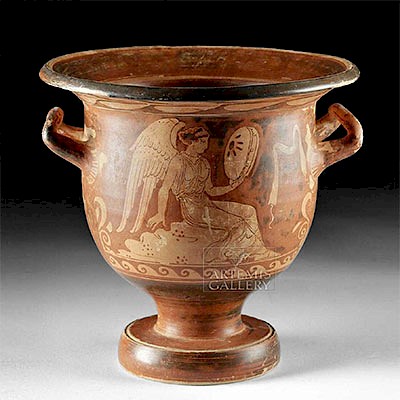Tall Luristan Bronze Master of Animals Finial
Lot 113
About Seller
Artemis Gallery
686 S Taylor Ave, Ste 106
Louisville, CO 80027
United States
Selling antiquities, ancient and ethnographic art online since 1993, Artemis Gallery specializes in Classical Antiquities (Egyptian, Greek, Roman, Near Eastern), Asian, Pre-Columbian, African / Tribal / Oceanographic art. Our extensive inventory includes pottery, stone, metal, wood, glass and textil...Read more
Estimate:
$2,000 - $3,500
Absentee vs Live bid
Two ways to bid:
- Leave a max absentee bid and the platform will bid on your behalf up to your maximum bid during the live auction.
- Bid live during the auction and your bids will be submitted real-time to the auctioneer.
Bid Increments
| Price | Bid Increment |
|---|---|
| $0 | $25 |
| $300 | $50 |
| $1,000 | $100 |
| $2,000 | $250 |
| $5,000 | $500 |
| $10,000 | $1,000 |
| $20,000 | $2,500 |
| $50,000 | $5,000 |
| $100,000 | $10,000 |
| $200,000 | $20,000 |
About Auction
By Artemis Gallery
Mar 7, 2019
Set Reminder
2019-03-07 10:00:00
2019-03-07 10:00:00
America/New_York
Bidsquare
Bidsquare : VARIETY SALE | Antiquities & Ethnographic Art
https://www.bidsquare.com/auctions/artemis-gallery/variety-sale-antiquities-ethnographic-art-3928
Around the world & back in time - be amazed at the treasures you will find. Antiquities from Egypt, Greece, Italy and the Near East, Asian, Pre-Columbian, African / Tribal / Oceanic, Native American, Spanish Colonial, Russian Icons, Fine Art, much more! Artemis Gallery info@artemisgallery.com
Around the world & back in time - be amazed at the treasures you will find. Antiquities from Egypt, Greece, Italy and the Near East, Asian, Pre-Columbian, African / Tribal / Oceanic, Native American, Spanish Colonial, Russian Icons, Fine Art, much more! Artemis Gallery info@artemisgallery.com
- Lot Description
Ancient Near East, northwestern Iran, Luristan, ca. 1000 to 600 BCE. A beautiful bronze tubular standard in the form of a "master of animals," rendered as a rod between the head and necks of stylized predators - these resemble wolves, while other examples often have lionesses. The piece connects by a pin to a bell-shaped body used for attachment or placement in an altar. A mask-like Janiform face is at the center of the figure's body, and two other animals - perhaps roosters - project outwards from below the arms. Many of these standards were removed from Luristan in the 1800s and early 1900s without proper archaeological excavation; only two have been scientifically excavated. As a result, their true function is unknown. Suggestions for their interpretation have ranged from the religious - depictions of deities, idols, talismans, etc. - to the utilitarian - parts of chariots or used in funerary rituals. Size: 2.5" W x 13.8" H (6.4 cm x 35.1 cm); 17.5" H (44.4 cm) on included custom stand.
For a very similar example, please see "Our Collective Past: A Selection of Objects from Antiquity." Fortuna Fine Arts, Inc., New York, 2006, p. 2, fig. 2.
Provenance: private East Coast, USA collection
All items legal to buy/sell under U.S. Statute covering cultural patrimony Code 2600, CHAPTER 14, and are guaranteed to be as described or your money back.
A Certificate of Authenticity will accompany all winning bids.
We ship worldwide and handle all shipping in-house for your convenience.
#139812Pin between top and bottom components is modern and used for stabilization purposes. Slight bending to overall form, light softening to some finer details, with minor nicks and abrasions to figure, animals, and body. Light earthen deposits as well as fabulous green and brown patina throughout.Condition
- Shipping Info
-
All shipping is handled in-house for your convenience. Your invoice from Artemis Gallery will include shipping calculation instructions. If in doubt, please inquire BEFORE bidding for estimated shipping costs for individual items.
-
- Buyer's Premium



 EUR
EUR CAD
CAD AUD
AUD GBP
GBP MXN
MXN HKD
HKD CNY
CNY MYR
MYR SEK
SEK SGD
SGD CHF
CHF THB
THB














